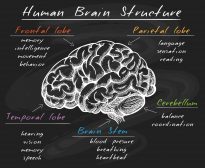Table of Contents
Definition
noun
plural: lysosomal enzymes
ly·so·somal en·zyme, ˈlaɪsəˌsoʊm əl ˈɛnzaɪm
(biochemistry) Any of the degradative enzymes of the lysosome
Details
Overview
The lysosome is the cytoplasmic structure that is primarily involved in the degradation of materials. It is essentially a spherical vesicle with various digestive (hydrolytic) enzymes. These enzymes associated with the digestion of macromolecules from phagocytosis, endocytosis, and autophagy, and digestion of bacteria and other waste materials are referred to as lysosomal enzymes. They enable the lysosome to serve as the cell’s waste disposal system.
Characteristics
Lysosomal enzymes that are synthesized in the rough endoplasmic reticulum. Next, they undergo post-translational modifications by adding mannose 6-phosphate as a label in the Golgi apparatus. Finally, they are imported as vesicles by budding off from the Golgi apparatus. The enzymes inside the vesicles will be used primarily for digestion and removal of excess or worn-out organelles, food particles, and engulfed viruses or bacteria. The lumen of the lysosomes has a pH ranging from 4.5 to 5.0, which is optimal for the enzymes for hydrolysis.
Types
There are a wide range of lysosomal enzymes. They may be classified as phosphates (e.g. acid phosphatase, acid phosphodiesterase), nucleases (e.g. acid ribonuclease, acid deoxiribonuclease), polysaccharides (e.g. beta galactosidase, beta glucoronidase, lysozyme, hyaluronidase, arylsulphatase), proteases (e.g. cathepsin, collagenase, peptidase), and degradative lipid enzymes (e.g. esterase, phospholipase).
Biological function
Lysosomal enzymes hydrolyze materials for digestion. Lysozyme, for instance, assists in the hydrolysis of glycosidic bond between N-acetyl muramic acid and N-acetyl glucosamine. Another example is the acid alpha-glucosidase that aids in the breakdown of glycogen inside the lysosome. Lysosomal acid phosphatase is an enzyme that catalyzes the release of phosphate groups of phospholipids.
Common biological reactions
Common biological reactions
Lysosomes digest materials as catalyzed by hydrolytic enzymes located in their membrane and lumen. The first step is endocytosis wherein the material enters the cell through the cell membrane in the form of a food vacuole. Next, the lysosome fuses with the food vacuole releasing its hydrolytic enzymes into the food vacuole. Lastly, the hydrolytic enzymes digest the materials inside. The vesicle, then, shrinks, forming small dense membrane-bound vesicles. The so-called residual bodies refer to the remnants of digested materials. 1
Pathobiology and Genetics
Lysosomal enzymes are encoded by the genes in the nucleus. Mutations in these genes could lead to genetic disorders since these mutations could result in dysfunctional lysosomal enzymes. When this occurs, metabolic disorders could ensue. Without a functional lysosomal enzyme, certain materials (metabolites, waste materials, etc.) tend to accumulate and could affect the normal, proper metabolism. This is the underlying cause of Tay-Sachs disease. Tay-Sachs disease is a disease characterized by neurodegeneration, developmental disability, or even early death. It is caused by a deficiency in a functional hexosaminidase A resulting in the accumulation of GM2 gangliosides in neurons. Other metabolic disorders caused by a mutation resulting in dysfunctional or a deficiency of functional lysosomal enzymes are Farber disease, Krabbe disease, galactosialidosis, gangliosides, alpha-galactosidase (e.g. Fabry disease, Schindler disease, etc.), beta-galactosidase, GM2 gangliosidosis (e.g. Sandhoff disease, Tay-Sachs disease, etc.), glucocerebroside (e.g. Gaucher disease), sphingomyelinase (e.g. lysosomal acid lipase deficiency), sulfatidosis, mucopolysaccharidosis, mucolipidosis, lipidosis (e.g. neuronal ceroid lipofuscinosis, Wolman disease, etc.), cholesterol ester storage disease, lysosomal transport disease, glycogen storage disease, etc. They are collectively called lysosomal storage disease.
Further reading
See also
Reference
- HISTOLOGY BIOL 4000 LECTURE 4. (2019). Retrieved August 21, 2019, from Auburn.edu website: http://www.auburn.edu/academic/classes/zy/hist0509/html/Lec03Bnotes-the_cell2.html
© Biology Online. Content provided and moderated by Biology Online Editors







